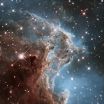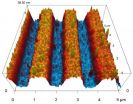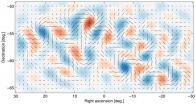(Press-News.org) To celebrate its 24th year in orbit, the NASA/ESA Hubble Space Telescope has released a beautiful new image of part of NGC 2174, also known as the Monkey Head Nebula. This colourful region is filled with young stars embedded within bright wisps of cosmic gas and dust.
NGC 2174 lies about 6400 light-years away in the constellation of Orion (The Hunter). Hubble previously viewed this part of the sky back in 2001, creating a stunning image released in 2011, and the space telescope has now revisited the region to celebrate its 24th year of operation.
Nebulae are a favourite target for Hubble. Their colourful plumes of gas and fiery bright stars create ethereally beautiful pictures. Some of the most famous of Hubble's images have been of nebulae -- for example, the telescope's 22nd and 23rd anniversary images of the Tarantula (heic1206 - http://spacetelescope.org/news/heic1206/) and Horsehead (heic1307 - http://spacetelescope.org/news/heic1307/) nebulae, and its festive 2012 image of planetary nebula NGC 5189 (heic1220 - http://www.spacetelescope.org/news/heic1220/).
The detail shown in this image lies within NGC 2174, a nebula which gets its more common name, the Monkey Head Nebula, from its curiously familiar shape when viewed in wide-field images.
The nebula is a violent stellar nursery, packed with the ingredients needed for star formation. However, the recipe for cooking up new stars isn't very efficient and most of the ingredients are wasted as the cloud of gas and dust disperses. This process is accelerated by the presence of fiercely hot young stars which trigger high velocity winds that help to blow the gas outwards.
A vibrant palette of colours can be seen in this new image of NGC 2174. Dark brown and rust-coloured dust clouds billow outwards, framed against a background of bright blue gas. These striking hues are formed by combining several Hubble images taken with different coloured filters, to reveal a broad range of colours not normally visible to the human eye.
The icing on this cosmic birthday cake takes the form of young white and pink stars sprinkled amongst the glowing clouds, pushing away the dark stellar nurseries in which they formed. The key ingredient in NGC 2174 is hydrogen gas, which is ionised by the ultraviolet radiation emitted by the young stars. As a result, this region is also known as an HII region [1] -- a large cloud of ionised gas.
This image marks 24 years of Hubble. This milestone will be further celebrated by a conference being held in Rome, Italy, in March of this year. The conference, entitled Science with the Hubble Space Telescope IV - (http://www.stsci.edu/institute/conference/hst4), will highlight and celebrate the scientific breakthroughs that Hubble has made over the last two decades and look into the future at the topics and key questions that will shape the field of astrophysics in the next decade.
This portion of the Monkey Head Nebula was imaged in the infrared using Hubble's Wide Field Camera 3. Hubble's earlier Wide Field Planetary Camera 2 image from 2011 inspired its choice as the telescope's 24th anniversary image. A processed version of the WFPC2 dataset was entered into the Hubble's Hidden Treasures image processing competition by Yurij Tukachev.
INFORMATION:
Notes
[1] An HI region (pronounced "H-one") contains a lot of neutral hydrogen, an HII (pronounced "H-two") lots of ionised hydrogen, and a H2 region molecular hydrogen.
Notes for editors
The Hubble Space Telescope is a project of international cooperation between ESA and NASA.
More information
Image credit: NASA, ESA, and the Hubble Heritage Team (STScI/AURA)
Links
Images of Hubble - http://www.spacetelescope.org/images/archive/category/spacecraft/
Hubble Heritage release - http://heritage.stsci.edu/2014/18/
NASA release - http://hubblesite.org/newscenter/archive/releases/2014/18
Contacts
Georgia Bladon
ESA/Hubble, Public Information Officer
Garching bei München, Germany
Tel: +49-89-3200-6855
Email: gbladon@partner.eso.org
Hubble revisits the Monkey Head Nebula for 24th birthday snap
2014-03-18
ELSE PRESS RELEASES FROM THIS DATE:
Crop intensification and organic fertilizers can be a long-term solution to perennial food shortages in Africa
2014-03-18
Farmers in Africa can increase their food production if they avoid over dependence on chemical fertilizers, pesticides and practice agricultural intensification - growing more food on the same amount of land – using natural and resource-conserving approaches such as agroforestry.
According to scientists at the World Agroforestry Centre (ICRAF), crop production in Africa is seriously hampered by the degradation of soil fertility, water and biodiversity resources. Currently, yields for important cereals such as maize have stagnated at 1 tone per hectare. Climate change ...
Researchers change coercivity of material by patterning surface
2014-03-18
Researchers from North Carolina State University have found a way to reduce the coercivity of nickel ferrite (NFO) thin films by as much as 80 percent by patterning the surface of the material, opening the door to more energy efficient high-frequency electronics, such as sensors, microwave devices and antennas.
"This technique reduces coercivity, which will allow devices to operate more efficiently, reducing energy use and improving device performance," says Goran Rasic, a Ph.D. student at NC State and lead author of a paper describing the work. "We did this work on NFO ...
New research links body clocks to chronic lung diseases
2014-03-18
The body clock's natural rhythm could be utilized to improve current therapies to delay the onset of chronic lung diseases.
Scientists at The University of Manchester have discovered a rhythmic defence pathway in the lung controlled by our body clocks, which is essential to combat daily exposure to toxins and pollutants.
Internal biological timers (circadian clocks) are found in almost all living things driving diverse processes such as sleep/wake cycles in humans to leaf movement in plants. In mammals including humans, circadian clocks are found in most cells and ...
Earthquakes caused by clogged magma a warning sign of eruption, study shows
2014-03-18
New research in Geophysical Research Letters examines earthquake swarms caused by mounting volcanic pressure which may signal an imminent eruption. The research team studied Augustine Volcano in Alaska which erupted in 2006 and found that precursory earthquakes were caused by a block in the lava flow.
36 hours before the first magmatic explosions, a swarm of 54 earthquakes was detected across the 13-station seismic network on Augustine Island. By analyzing the resulting seismic waves, the authors found that the earthquakes were being triggered from sources within the ...
Eat more, die young: Why eating a diet very low in nutrients can extend lifespan
2014-03-18
A new evolutionary theory in BioEssays claims that consuming a diet very low in nutrients can extend lifespan in laboratory animals, a finding which could hold clues to promoting healthier ageing in humans.
Scientists have known for decades that severely restricted food intake reduces the incidence of diseases of old age, such as cancer, and increases lifespan.
"This effect has been demonstrated in laboratories around the world, in species ranging from yeast to flies to mice. There is also some evidence that it occurs in primates," says lead author, Dr Margo Adler, ...
Follow the ant trail for drug design
2014-03-18
This news release is available in German. The path to developing new drugs is a long one. If a target is identified for a new active agent – for instance a particular protein that plays a key role in a disease – an active molecule that binds to the target must then be developed. Pharmaceutical companies trawl through their collections of chemicals for substances that act on the target protein in the desired fashion. However, these compounds are often just the starting point for a long process of adjustment and testing. Chemists use computer simulations to design new ...
Democrats, Republicans see each other as mindless -- unless they pose a threat
2014-03-18
We are less likely to humanize members of groups we don't belong to—except, under some circumstances, when it comes to members of the opposite political party. A study by researchers at New York University and Harvard Business School suggests that we are more prone to view members of the opposite political party as human if we view those individuals as threatening.
"It's hardly surprising that we dehumanize those who are not part of our groups," says Jay Van Bavel, an assistant professor in NYU's Department of Psychology and one of the study's co-authors. "However, what ...
Research on the protein gp41 could help towards designing future vaccinations against HIV
2014-03-18
This news release is available in Spanish. Researchers from the University of Granada have discovered, for the first time, an allosteric interaction (that is, a regulation mechanism whereby enzymes can be activated or de-activated) between this protein, which forms part of the sheath of the Human Immunodeficiency Virus (HIV) and the antibody 2F5 (FAB), a potent virus neutralizer. This important scientific breakthrough could help specialists to understand the mechanisms behind generating immune responses and help towards the design of future vaccines against the HIV ...
First direct evidence of cosmic inflation
2014-03-18
Almost 14 billion years ago, the universe we inhabit burst into existence in an extraordinary event that initiated the Big Bang. In the first fleeting fraction of a second, the universe expanded exponentially, stretching far beyond the view of our best telescopes. All this, of course, was just theory.
Researchers from the BICEP2 collaboration today announced the first direct evidence for this cosmic inflation. Their data also represent the first images of gravitational waves, or ripples in space-time. These waves have been described as the "first tremors of the Big Bang." ...
Immunologists present improved mass spectrometric method for proteomic analyses
2014-03-18
When it comes to analyzing cell components or body fluids or developing new medications, there is no way around mass spectrometry. Mass spectrometry is a highly sensitive method of measurement that has been used for many years for the analysis of chemical and biological materials. Scientists at the Institute of Immunology of the University Medical Center of Johannes Gutenberg University Mainz (JGU) have now significantly improved this analytical method that is widely employed within their field. They have also developed a software program for the integrated analysis of ...




